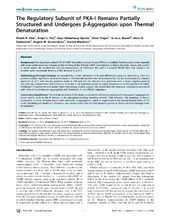| dc.contributor.author | Dao, Khanh K. | en_US |
| dc.contributor.author | Pey, Angel | en_US |
| dc.contributor.author | Gjerde, Anja Underhaug | en_US |
| dc.contributor.author | Teigen, Knut | en_US |
| dc.contributor.author | Byeon, In-Ja L. | en_US |
| dc.contributor.author | Døskeland, Stein Ove | en_US |
| dc.contributor.author | Gronenborn, Angela M. | en_US |
| dc.contributor.author | Martinez, Aurora | en_US |
| dc.date.accessioned | 2012-02-21T10:55:32Z | |
| dc.date.available | 2012-02-21T10:55:32Z | |
| dc.date.issued | 2011-03-04 | eng |
| dc.Published | PLoS ONE 6(3): e17602 | en |
| dc.identifier.issn | 1932-6203 | |
| dc.identifier.uri | https://hdl.handle.net/1956/5629 | |
| dc.description.abstract | Background: The regulatory subunit (R) of cAMP-dependent protein kinase (PKA) is a modular flexible protein that responds with large conformational changes to the binding of the effector cAMP. Considering its highly dynamic nature, the protein is rather stable. We studied the thermal denaturation of full-length RIa and a truncated RIa(92-381) that contains the tandem cyclic nucleotide binding (CNB) domains A and B. Methodology/Principal Findings: As revealed by circular dichroism (CD) and differential scanning calorimetry, both RIa proteins contain significant residual structure in the heat-denatured state. As evidenced by CD, the predominantly a-helical spectrum at 25uC with double negative peaks at 209 and 222 nm changes to a spectrum with a single negative peak at 212–216 nm, characteristic of b-structure. A similar aRb transition occurs at higher temperature in the presence of cAMP. Thioflavin T fluorescence and atomic force microscopy studies support the notion that the structural transition is associated with cross-b-intermolecular aggregation and formation of non-fibrillar oligomers. Conclusions/Significance: Thermal denaturation of RIa leads to partial loss of native packing with exposure of aggregationprone motifs, such as the B’ helices in the phosphate-binding cassettes of both CNB domains. The topology of the bsandwiches in these domains favors inter-molecular b-aggregation, which is suppressed in the ligand-bound states of RIa under physiological conditions. Moreover, our results reveal that the CNB domains persist as structural cores through heatdenaturation. | en_US |
| dc.language.iso | eng | eng |
| dc.publisher | Public Library of Science | eng |
| dc.rights | Attribution CC BY | eng |
| dc.rights.uri | http://creativecommons.org/licenses/by/2.5/ | eng |
| dc.title | The Regulatory Subunit of PKA-I Remains Partially Structured and Undergoes b-Aggregation upon Thermal Denaturation | en_US |
| dc.type | Peer reviewed | |
| dc.type | Journal article | |
| dc.description.version | publishedVersion | en_US |
| dc.rights.holder | Copyright 2011 Dao et al. | |
| dc.identifier.doi | https://doi.org/10.1371/journal.pone.0017602 | |
| dc.subject.nsi | VDP::Mathematics and natural science: 400::Basic biosciences: 470 | eng |

